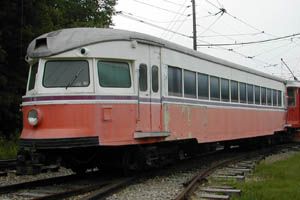
- Builder
- J. G. Brill Co.
- Description
- 'Bullet' car
- Secondary Use
- None
- Type
- Interurban Cars
- Year
- 1931
- Retired from Service
- 1991
- Acquired by the Museum
- 1991
- Fund
- 846
SEPTA 208
From Philadelphia, Pennsylvania
History
The Philadelphia & Western Ry. began operating in 1907 with an 11-mile, third-rail powered line from 69th Street in Upper Darby, PA to Strafford, PA. At 69th St., on the western boundary of Philadelphia, the P&W connected with the Philadelphia Rapid Transit’s elevated line to center city Philadelphia. In 1912, the P&W opened a branch from Villanova to Norristown. The 13.5-mile 69th St. to Norristown route became the main line and connected at Norristown with the Lehigh Valley Transit’s interurban line to Allentown.
In 1930, the P&W responded to a sharp drop in revenues by turning management over to Dr. Thomas Conway, Jr. who had just revitalized the Cincinnati & Lake Erie interurban. Conway joined with J.G. Brill Company to design new equipment that would improve service and reduce costs. To design a vehicle with reduced wind resistance, Conway and Brill hired a University of Michigan aeronautics professor to test models in a wind tunnel. The result was a streamlined, lightweight, all-aluminum “bullet” car with a low roof and free of clutter. In 1931, Brill built 10 “bullet” cars, Nos. 200-209, for the P&W. The “bullet” cars cut power costs by 43% and reduced the running time on the Norristown line from 24 minutes to 17 minutes. These were the first streamlined electric cars in the U.S., the first all-aluminum cars and the first to have used extensive wind tunnel tests. This design predated the first steam railroad streamliners by several years and foreshadowed the streamline style that became popular for many products later in the 1930s. Brill hoped the “bullet” car would modernize and save the remaining interurban industry, but Brill sold only five other “bullet” cars, to New York’s Fonda Johnstown & Gloversville Ry.
The P&W painted its “bullet” cars dark red with gold lettering and ran them exclusively on the Norristown line. In 1948, the Philadelphia Suburban Transportation Co. acquired control of the P&W. The PSTC, known as the “Red Arrow” Lines, operated trolley lines out of the same 69th Street terminal to other Philadelphia suburbs. In 1953, the P&W merged into the PSTC. In 1963, the PSTC acquired the Chicago North Shore & Milwaukee’s two Electroliner streamliners to supplement the “bullet” cars on the Norristown line. In 1970, the Southeast Pennsylvania Transportation Authority, a state agency, acquired the PSTC and repainted the “bullet” cars into SEPTA’s scheme of white with orange and blue stripes. In 1987, SEPTA began replacing “bullet” car service with used rapid transit cars from Chicago. In 1991, SEPTA finally retired the “bullet” cars after a remarkable 60 years in service. The cars’ route has some characteristics of a rapid transit line, but, if considered an interurban, the line joins the Chicago South Shore & South Bend as the nation’s only surviving interurbans, due in large part to the success of the “bullet” cars.
At their retirement in 1991, Seashore purchased at auction three “bullet” cars: No. 203, No. 207 and No. 208. No. 207 had been wrecked and was acquired for parts. Prior to retirement, SEPTA had sent No. 208 to its Woodland Overhaul Facility for structural repairs. No. 208 was still partially disassembled when Seashore acquired the car but was in better condition than No. 203. While Seashore gave No. 203 a cosmetic restoration, the museum held No. 208 for possible restoration to operating condition. No. 208 received some roof repairs in 1996. Another “bullet” car, No. 205, is in operation at the Rockhill Trolley Museum at Rockhill Furnace, PA. Seashore identifies No. 208 as a rapid transit car in its accession number, but, in some cases, Seashore considers it an interurban car.
Technical Information
- Seats: 56
- Control: PC-12 (C-129)
- Brakes: SME (M35)
- Compressor: DH-20
Trucks
- Number: 2
- Manufacturer: Brill
- Model: 89E-2
Motor
- Number: 4
- Manufacturer: General Electric
- Model: 706B2
Weight and Dimensions
- Length: 55’
- Width: 9’ 1.00"
- Height: 10’ 6.00"
- Weight: 52290 lbs.
Additional Images

Sister car 200 in Philadelphia suburbs in 02/1971 - Joe Testagrose at newdavesrailpix.com
© 1998 - 2025 New England Electric Railway Historical Society. All Rights Reserved.